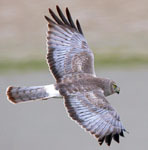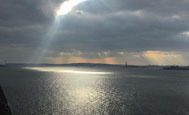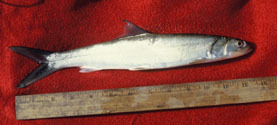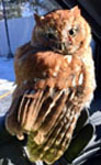Hudson River Almanac 1/26/19 - 2/01/19
The New York State Department of Environmental Conservation sent this bulletin on 02/08/2019 02:00 PM EST |
| DEC Delivers - Information to keep you connected and informed from the NYS Department of Environmental Conservation |
| Share or view as a web page || Update preferences or unsubscribe |
Hudson River Almanac
|
Compiled by Tom Lake, Hudson River Estuary Program Consulting NaturalistOverviewThis was a week of Arctic air and an ice-filled river. Those two factors drove scores of bald eagles south and out onto ice floes making for terrific viewing.Highlight of the Week 1/28 – Anthony’s Nose to Croton Point, HRM 46-34: Our annual E.A. Mearns Bird Club Hudson River Bald Eagle trip (20 members) began on the east side of the river in Westchester County at the scenic overlook of Routes 6/202. There was plenty of ice on the river beginning with 75% coverage at Bear Mountain to 25% at Croton Point. Bald eagles were everywhere along our 12-mile journey, perched in trees, flying in tandem, tumbling through the air, and just sitting on the ice floes. At one point, we counted 18 eagles on a single ice floe. Our final tally for the day was 177 bald eagles. Other raptors included red-tailed hawk, Cooper's hawk, red-shouldered hawk, northern harrier, merlin, peregrine falcon, and a great horned owl. It was a thrilling day, the kind of day that makes you appreciate the beauty of the Hudson River Valley. (Photo of northern harrier courtesy of Tim Avery) 1/28 – Anthony’s Nose to Croton Point, HRM 46-34: Our annual E.A. Mearns Bird Club Hudson River Bald Eagle trip (20 members) began on the east side of the river in Westchester County at the scenic overlook of Routes 6/202. There was plenty of ice on the river beginning with 75% coverage at Bear Mountain to 25% at Croton Point. Bald eagles were everywhere along our 12-mile journey, perched in trees, flying in tandem, tumbling through the air, and just sitting on the ice floes. At one point, we counted 18 eagles on a single ice floe. Our final tally for the day was 177 bald eagles. Other raptors included red-tailed hawk, Cooper's hawk, red-shouldered hawk, northern harrier, merlin, peregrine falcon, and a great horned owl. It was a thrilling day, the kind of day that makes you appreciate the beauty of the Hudson River Valley. (Photo of northern harrier courtesy of Tim Avery)- Gerhard Patsch Natural History Entries1/26 – Putnam County, HRM 54: I had a common redpoll and some pine siskins [winter finches] on the ground under my feeder today feeding with the house finches that stay here all winter. I think the Arctic winds drove the redpoll and siskins south into the Hudson Valley.- Connie Mayer-Bakall  1/26 – West Point, HM 52: A lone snow goose has been hanging around West Point, in the river and on a nearby grassy field, for two weeks. It has been in the company of a huge gaggle of Canada geese numbering in the hundreds. I first saw it on a foggy morning in the field where it “glowed” while the Canada geese were just dark shapes. (Photo of snow goose courtesy of Tim Judd) 1/26 – West Point, HM 52: A lone snow goose has been hanging around West Point, in the river and on a nearby grassy field, for two weeks. It has been in the company of a huge gaggle of Canada geese numbering in the hundreds. I first saw it on a foggy morning in the field where it “glowed” while the Canada geese were just dark shapes. (Photo of snow goose courtesy of Tim Judd)- Tim Judd 1/27 – Washington County, HRM 209: At the Washington County Grasslands Wildlife Management Area this afternoon, we counted a dozen rough-legged hawks (three dark-phase, nine light morphs). The amazing afternoon also included a “gray ghost” (male northern harrier), two red-tailed hawks, and a male American kestrel. - Scott Varney (Hudson-Mohawk Bird Club) 1/27 – Saratoga County, HRM 200: I went back again this morning to explore the Northumberland farmlands to look for field birds. I did not come upon any large flocks, but I estimated there were 30 horned larks, 20 snow buntings, and five Lapland longspurs, mostly along the edge of the road at several spots. The longspurs blend in so well with the other birds, it can be difficult to spot them. - John Hershey (Hudson-Mohawk Bird Club) 1/27 – Greene County, HRM 113: While taking a winter walk in mid-afternoon at Mawignack Preserve in Greene County, we spotted a large kettle of black vultures (35) overhead. I spent several minutes combing through the kettle, looking for a hawk (Buteo sp.). However, the kettle was through-and-through black vulture. They were remarkably lined up, single-file, and finally dropped altitude out of view – I thought, perhaps, they were heading to a night roost. - Ryan J. Bass [Since expanding their range northward over the past decade, black vultures have become the wintering vultures in our region. Rich Guthrie] 1/27 – Newburgh, HRM 60: I spotted an Iceland gull today at the Newburgh waterfront, a place where large numbers of gulls often gather during the day in winter. However, I was unable to find the second-year Iceland gull and first-year Glaucous gull found there by Curt McDermott and Ken McDermott five days ago. - Bruce Nott 1/27 – Charles Point to Verplanck, HRM 43-40: Our first stop today on our bald eagle tour was at Charles Point where we were able to spot 22 bald eagles out on the “hummocky” ice of Peekskill Bay. At least 17 of them were adults. One was particularly prominent perched proudly on the tip of a large upturned plate of ice. At the north end of the bay, a dozen double-crested cormorants crowded together on an isolated ice floe trying to dry their wings by assuming their “Dracula” pose. Two rafts of common mergansers drifted and fished open sections of water. Another dozen bald eagles – 50:50 adults and immatures – were drifting north on the ice off Old Steamboat Dock a few miles downriver in Verplanck. - Dave Lindemann, Mary Lou Lindemann  1/27 – Verplanck, HRM 40.5: We were on Old Steamboat Dock in mid-morning watching bald eagles, both adults and immatures, out on the ice. We got a great look at a ring-billed gull eating on the run, with a white perch in its bill. (Photo of ring-billed gull courtesy of Deborah Tracy-Kral) 1/27 – Verplanck, HRM 40.5: We were on Old Steamboat Dock in mid-morning watching bald eagles, both adults and immatures, out on the ice. We got a great look at a ring-billed gull eating on the run, with a white perch in its bill. (Photo of ring-billed gull courtesy of Deborah Tracy-Kral)- Deborah Tracy-Kral, John Badura 1/28 – Delmar, HRM 143: With a winter storm approaching, the northern cardinals were flocking to our feeders. We counted at least ten at one time, seven females and three males. Before today, we’ve had only one pair. - Alan Mapes (Hudson-Mohawk Bird Club) 1/28 – Queens, New York City: This was my first day back from a thirty-five-day government furlough. My rounds took me to the various sites that together, comprise the National Park Service’s Gateway National Recreation Area. As I stopped in Howard Beach at the corner of 83rd Street and 163rd Avenue, I saw a beautiful “gray ghost” (male northern harrier) as it banked gracefully and turned without so much as flapping his black-tipped wings. Veering away from the road, he disappeared over distant acres of Phragmites and switch grass. Everything seemed fine at this part of the park despite the shut-down. I imagine my harrier friend didn’t miss me at all. - Dave Taft 1/29 – East Fishkill, HRM 66: Our coyotes have been howling and making a middle-of-the-night racket every night this week. This is prime time for their breeding (mating) season. I shined a light into the forest and saw their eyes looking back at me. (The light briefly quieted them down.) Last night, our local gray fox came for a visit as well. It appeared healthy, well-fed, and looked beautiful. - Diane Anderson  1/29 – Manhattan, HRM 1: We were still looking for our first fish of 2019 as we checked our research sampling gear in Hudson River Park at The River Project's sampling station on the lighthouse tender Lilac at Pier 25. The river said “not yet” for a fish, but in our killifish pot we found shore shrimp (Palaemonetes sp.), mud crabs (Panopeidae), and isopods. (Photo of New York Harbor - Upper Bay courtesy of Robert Simko) 1/29 – Manhattan, HRM 1: We were still looking for our first fish of 2019 as we checked our research sampling gear in Hudson River Park at The River Project's sampling station on the lighthouse tender Lilac at Pier 25. The river said “not yet” for a fish, but in our killifish pot we found shore shrimp (Palaemonetes sp.), mud crabs (Panopeidae), and isopods. (Photo of New York Harbor - Upper Bay courtesy of Robert Simko)- Siddhartha Hayes, Toland Kister 1/30 – Newcomb, HRM 302: We are seeing lots of American marten and snowshoe hare tracks. Birds at the feeders have been a line-up of the usual suspects: black-capped chickadees, nuthatches, blue jays, and hairy and downy woodpeckers. There was also an abundance of red squirrels at the feeders thanks to the poor cone crop. I counted nine red squirrels feeding under the bird feeders at the SUNY ESF Interpretive Center today. I also have four red squirrels and two gray squirrels making an adorable nuisance of themselves at my home feeders. Hard to get mad at the hungry little rodents when they were covered in snow, and the high temperature for the day was in the single digits. - Charlotte Demers *** Fish of the Week *** With winter here and much of the watershed’s ponds, creeks, lakes, and rivers iced-over, some of us are going through fish withdrawal. As a coping device, until fully open water returns in March, we will have a “Fish of the Week” feature.  1/30 – Hudson Valley Estuary: This week’s fish is the ladyfish (Elops saurus), species number 17 (of 228) on our watershed list of fishes. Ladyfish are a long, slender, terete in cross-section, tropical, marine species. This relative of the tarpon are also known to anglers as ten-pounder, although they rarely grow to that size. While they can be found inshore along the Atlantic Coast north into New England, their center of abundance mirrors the tarpon, from the Carolinas south to Florida. 1/30 – Hudson Valley Estuary: This week’s fish is the ladyfish (Elops saurus), species number 17 (of 228) on our watershed list of fishes. Ladyfish are a long, slender, terete in cross-section, tropical, marine species. This relative of the tarpon are also known to anglers as ten-pounder, although they rarely grow to that size. While they can be found inshore along the Atlantic Coast north into New England, their center of abundance mirrors the tarpon, from the Carolinas south to Florida.They are one of the most ephemeral fishes on our watershed list with no more than a couple of records. One of the first occurred in October 1982 when a school of ladyfish appeared in the warm-water outflow of the power-generating facility at Danskammer Point (river mile 66.5). Of what seemed like at least a dozen ladyfish, we managed to capture just one. Its rarity earned it a place in the American Museum of Natural History’s collection of fishes in Manhattan. A few days later, Bob Vargo Sr. found a school of ladyfish in the warm-water outflow of the power-generating facility at Indian Point (river mile 42). These tropical marine fishes may have been heading seaward as autumn went on. If you would like a copy of our watershed fish list, e-mail: trlake7@aol.com. (Photo of ladyfish courtesy of Tom Lake) - Tom Lake 1/31 – Hudson River: Striped Bass Cooperative Angler Program. You can share your fishing trip information and help biologists understand and manage our Hudson River striped bass fishery. Here’s how it works: Fill out a logbook provided by us whenever you fish on the Hudson River (by boat or from shore). Record general location, time, gear used, what you caught (or if you didn’t catch anything) and return the logbook when you are done fishing. You’ll receive an annual newsletter summarizing the information in addition to the latest news regarding regulations and the river. Whether you catch-and-release or take home a keeper, you can be part of the Cooperative Angler Program. Join today by contacting: jessica.best@dec.ny.gov, or call 845-256-3009. - Jessica Best 1/31– Hudson River: Three weeks ago, our Fish of the Week featured the inshore lizardfish (Synodus foetens). Several readers expressed interest in learning more about them, especially in the estuary. A good primary source is the journal article Occurrence of Larval Inshore Lizardfish in the Hudson River Estuary, Michael Tabery, Arthur Ricciardi, Theodore Chambers. New York Fish and Game Journal 25(1), January 28, 1978. - Tom Lake 2/1 – Newcomb, HRM 302: We received an additional 49 inches of snow in January, just over twice the 30-year average for the month. The winter season overall has been snowy; we only need another 17” to meet the 106” average typical of the Newcomb area. - Charlotte Demers 2/1 – Glens Falls, HRM 208: This was the fifth straight day of below zero air temperatures, culminating in a reading of -15 degrees Fahrenheit, one-degree shy of the record for the date of minus19 degrees. - National Weather Service [A lobe of the high-altitude Polar Vortex had broken off and descended south into the Hudson Valley delivering Arctic and near record air temperatures. National Weather Service]  2/1 – Fort Montgomery, HRM 46.5: While driving the back roads in Fort Montgomery, I came upon ten crows acting wildly in the middle of the road. As I approached, the crows scattered and I found a little rufous-phase eastern screech owl in their wake. It looked a bit roughed-up, but was still alive. I transported it to Bear Mountain State Park. Melissa Gillmer, Trailside Museum’s head zoo keeper, examined the owl and found it to be in pretty good shape, although a little thin and dehydrated. She was optimistic that the owl would survive, and that a wildlife-rehabilitator would take care of it before releasing it where I found it. (Photo of screech owl courtesy of William Sherwood) 2/1 – Fort Montgomery, HRM 46.5: While driving the back roads in Fort Montgomery, I came upon ten crows acting wildly in the middle of the road. As I approached, the crows scattered and I found a little rufous-phase eastern screech owl in their wake. It looked a bit roughed-up, but was still alive. I transported it to Bear Mountain State Park. Melissa Gillmer, Trailside Museum’s head zoo keeper, examined the owl and found it to be in pretty good shape, although a little thin and dehydrated. She was optimistic that the owl would survive, and that a wildlife-rehabilitator would take care of it before releasing it where I found it. (Photo of screech owl courtesy of William Sherwood)- William Sherwood Winter 2019 Natural History ProgramsVolunteer Opportunity: Hudson River Eel Project Free Trees for Streamside Planting The Hudson River Estuary Program’s Trees for Tribs program offers free native trees and shrubs for planting along the tributary streams in the Hudson River Estuary watershed. Our staff can help you with a planting plan and work with your volunteers. Since 2007, Trees for Tribs has provided more than 40,000 native trees and shrubs for planting along 20 miles of stream with the help of more than 9,000 local volunteers. We are now accepting applications for planting projects. For more information about the program or to download an application, please visit the DEC website at: https://www.dec.ny.gov/lands/43668.html. If you have questions about a potential planting site, please contact Beth Roessler at (845) 256-2253 or HudsonEstuaryTFT@dec.ny.gov. Hudson River MilesThe Hudson is measured north from Hudson River Mile 0 at the Battery at the southern tip of Manhattan. The George Washington Bridge is at HRM 12, the Tappan Zee 28, Bear Mountain 47, Beacon-Newburgh 62, Mid-Hudson 75, Kingston-Rhinecliff 95, Rip Van Winkle 114, and the Federal Dam at Troy, the head of tidewater, at 153. The tidal section of the Hudson constitutes a bit less than half the total distance – 315 miles – from Lake Tear of the Clouds to the Battery. Entries from points east and west in the watershed reference the corresponding river mile on the mainstem. To Contribute Your Observations or to SubscribeThe Hudson River Almanac is compiled and edited by Tom Lake and emailed weekly by DEC's Hudson River Estuary Program. Share your observations by e-mailing them to trlake7@aol.com.
|
